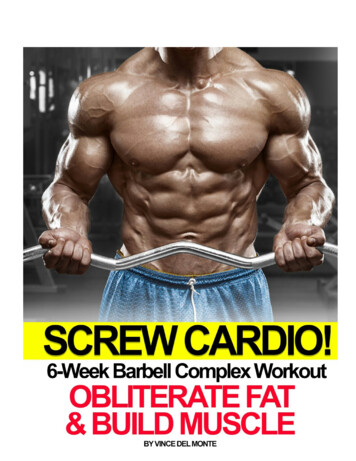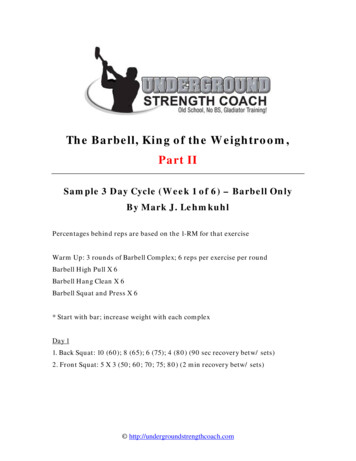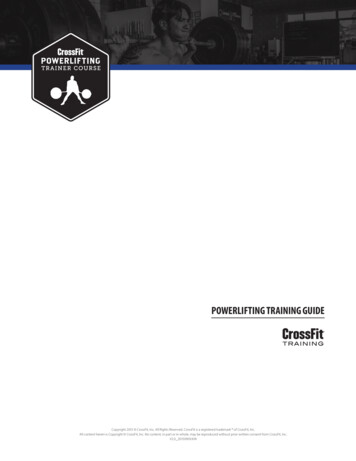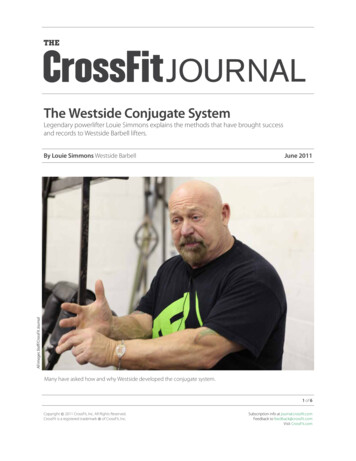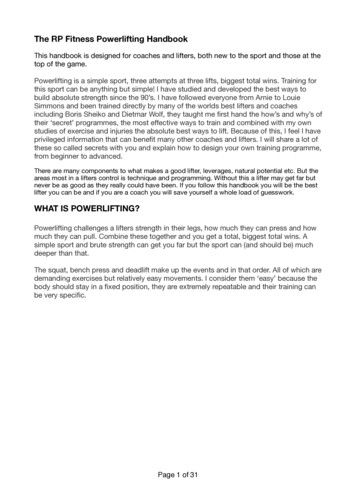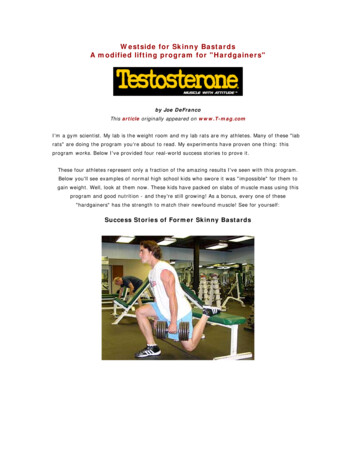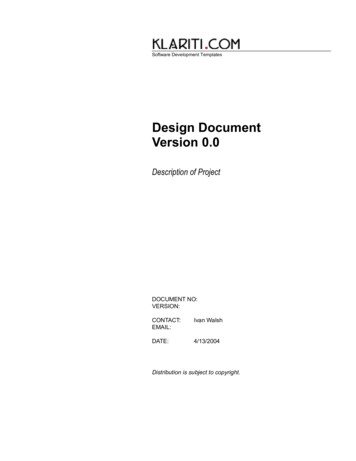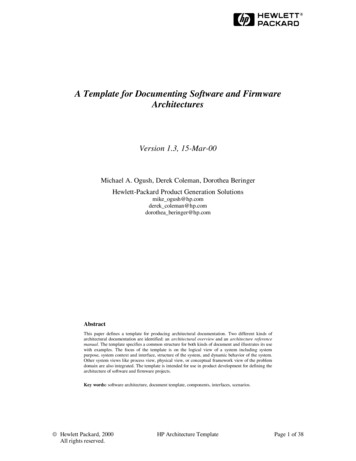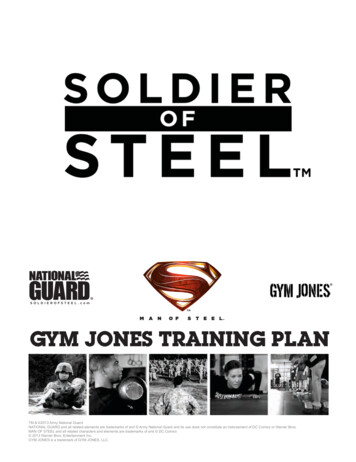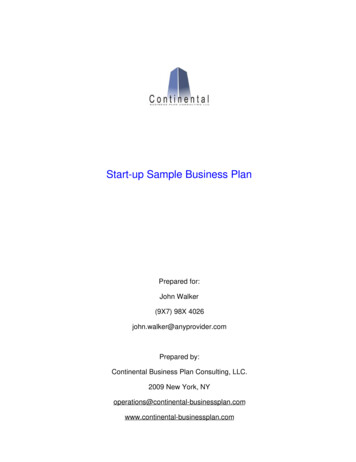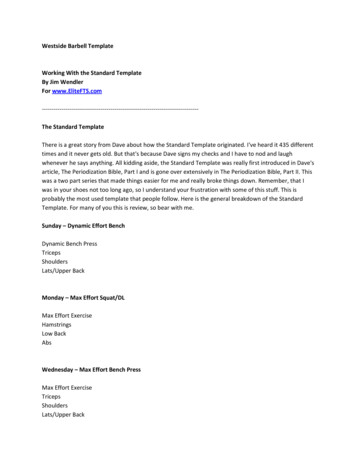
Transcription
Westside Barbell TemplateWorking With the Standard TemplateBy Jim WendlerFor ---------------------------------------------The Standard TemplateThere is a great story from Dave about how the Standard Template originated. I've heard it 435 differenttimes and it never gets old. But that's because Dave signs my checks and I have to nod and laughwhenever he says anything. All kidding aside, the Standard Template was really first introduced in Dave'sarticle, The Periodization Bible, Part I and is gone over extensively in The Periodization Bible, Part II. Thiswas a two part series that made things easier for me and really broke things down. Remember, that Iwas in your shoes not too long ago, so I understand your frustration with some of this stuff. This isprobably the most used template that people follow. Here is the general breakdown of the StandardTemplate. For many of you this is review, so bear with me.Sunday – Dynamic Effort BenchDynamic Bench PressTricepsShouldersLats/Upper BackMonday – Max Effort Squat/DLMax Effort ExerciseHamstringsLow BackAbsWednesday – Max Effort Bench PressMax Effort ExerciseTricepsShouldersLats/Upper Back
Friday – Dynamic Squat/DLDynamic SquatHamstringsLow BackAbsReview of the Standard Template2 days devoted to the bench press2 days devoted to the squat/deadlift2 days devoted to dynamic training2 days devoted to max effort training4 days devoted to repetition trainingNow let's review some of the training parameters within this template. For the sake of simplicity, I'mgoing to leave out chains and bands. Everything is going to be done with straight weight so there will beno confusion about percentages. Plus, I am going to leave out stance, grip changes, rest periods, etc. Inreality, most of this stuff is inconsequential once you grasp the big picture.Bench Press Parameters for the Standard Template (dynamic, max effort and repetition)Dynamic bench press – 8 sets of 3 repetitions; all sets done are done with 55% of raw 1RM. Rest periodsare approximately 60 seconds, but have never really seen the purpose of this, personally. The wholegoal of speed day is to move the bar quickly on the concentric. If you need to take an extra minute toaccomplish the goal of the day, then by all means, do so. Also, don't get too hung up on changing yourgrips. The only reason why I changed my grip on this day was to keep track of the number of sets I wasdoing. Again, remember why you are doing what you are doing.Max effort bench press – this includes a variety of exercises, but the most used are the floor press, 2board press, 3 board press, incline press and close grip bench press. On max effort bench press day, youpick one of these exercises and work to a 1RM. Most will switch to a different exercise every 1-2 weeksand simply try to break their record. On this day, based on your 1RM for THAT day, you will try to do 3lifts at or above 90%. You can take as much rest as you want, but I would probably say around 3-5minutes between your heaviest sets.Triceps – one day is devoted to high intensity/low volume triceps work, the other is devoted to lowintensity/high volume triceps. For example, high intensity triceps training would consist of 4 or 5 boardpresses or rack lockouts. The low intensity training will be geared to triceps extensions and pushdowns.On what day to put each of these is entirely up to you. In my experience, I've always had good results
putting the high intensity day on dynamic bench day.Shoulders – this is similar to the triceps in that there is a high intensity and low intensity day. The highintensity day is technically not high intensity, but high stress. In this category, I would put dumbbellbench press, dumbbell incline presses, military presses (with dumbbells or a straight bar) and dumbbellfloor presses. In the low stress category, front raises, side raises and rear raises are good choices. Again,you can choose which day to put them on, but I liked putting the high stress shoulder training ondynamic bench day.Lats/Upper back – Both days are devoted to lats and upper back and both are done with low intensity,high volume. The way that I worked this is that on Sunday, I would do lat work (usually a row or a pullup) and no upper back work. On Wednesday, I would do another lat workout (but with a differentexercise) and my low stress shoulder work would consist of a rear raise, face pull or a seated dumbbellpower clean. So essentially, on the low stress shoulder day, I would kill two birds with one stone: anupper back exercise with a low stress shoulder movement. I did this because I never did front raises orside raises and felt that I got enough stimulation from my other work. It's not gospel, but it's somethingto think about.Squat and Deadlift Parameters for the Standard TemplateDynamic Squat – All sets done on a parallel box. A three week wave is used using the following sets andreps.Week 1 – 10x2 @ 50%Week 2 – 10x2 @ 55%Week 3 – 10x2 @ 60%Upon completion of the 3rd week, you simply start the wave over again. All %'s are based on your bestsquat. Let's disregard equipment at this point and say it's based on your best 1RM of your box squatwearing whatever you usually wear on this day. Again, refer to my commentary on dynamic benchtraining regarding rest periods. This is not conditioning, this is speed work. Save your conditioning foranother time.Max Effort Squat and Deadlift – Similar to the max effort bench press, one exercise is used per week andworked up to a 1RM. Because most people have eliminated good mornings as a max effort exercise, Iwill choose the following for your exercises. I understand that many do not have these bars that I list,but this is the list, nonetheless:Safety squat bar squatCambered bar squatManta Ray squat(All squats are done on a low (1-2" below parallel), parallel or high (1-2" above parallel) box. As you cantell, there is a great many variations with these three exercises.
Rack deadlifts (or pin pulls)Deadlifts while standing on elevated platformReverse band deadliftsAgain, you want to hit around 3 lifts at or above 90% of your 1RM for that day. Most people switchexercises every week or every 2 weeks. Try to break your PR from your previous effort. To make thingseasier, simply switch between a squat movement and a deadlift movement. Rest 3-5 minutes betweenyour heaviest sets.Hamstrings – now here is where things get tricky. Unlike the shoulders/triceps routine of highintensity/low intensity, many people are weak at such exercises as the glute ham raise that they simplyneed to do the exercise and not worry so much about sets/reps. If you don't fall into this category, youcan do bodyweight glute ham raises on one day, and on the other day, you can add a band or a plate forresistance.Low Back – Again, we cannot really isolate the lower back without hitting the glutes and hamstrings. Butyou can pick from exercises such as back raises, 45 degree back raises, Reverse Hyperextensions, pullthroughs and good mornings. Depending on how you do some of these exercises (i.e. with a greatamount of intensity) you can use ONE of these for your hamstring and low back exercise. For example,good mornings can be done for both. If you were to pick reverse hyperextensions or pull-throughs, thenyou can get away with doing an extra hamstring exercise. Some people can train their lower back twice aweek, others cannot. A good way to do this is to pick one "easy" exercise (R.H., pull-throughs, unweighted back raises or band good mornings) on one day and pick a heavier exercise on the secondlower body training day.Abdominals – These are usually trained heavy twice a week in the standard template. Some goodexercises to choose from weighted sit ups, Roman Chair sit-ups, stability ball, hanging leg raises, sidebends. This is not very complicated but you just need to do them; that's usually the hardest part.So let's go over the pro's and con's of the standard template:Pro's of the Standard Template:Variation: Because you are doing a variety of exercises on max effort day, it helps keep things fresh andkeeps you motivated. Plus most people have never done board presses, floor presses or box squatsbefore trying the standard template, so there are a lot of new exercises being utilized.Record Breaking – You are doing two max effort days a week, so you have the ability to break a lot ofpersonal records. This can keep motivation high and give you tangible results NOW. This is one of thebest things about this template.Easy: I never thought I would say this but if you actually think about it, the standard template is prettyeasy to follow IF YOU THINK ABOUT IT. You have one slow and heavy day and one fast and light day for
the squat and bench press. After each of those days, you train the muscles that involve those lifts. Youtry to be fast on one day, try to lift heavy on the other day and get huge afterward.Combo of Max Effort, Dynamic Effort and Repetition Training: If done correctly, this combo is incredible.You can get fast, big and strong. These are three qualities that most people really want.Flexibility with Supplemental/Accessory lifts – If you are doing the correct loading on max effort anddynamic day, then you can really play around with the volume with your training on these lifts. Let meexplain: With the dynamic training, you are almost always operating within 50-60% and no matter whatmax effort exercise you choose, you are still operating around 90-100%. Now your volume can be raisedand lowered by your assistance lifts. This can give you a lot of room to play around with and allow you topick and choose exercises and volume based on how you feel that day.Con's of the Standard Template:Variation: Now stay with me on this one. Training for a big squat, bench and deadlift is not easy. But ifyou don't have good form on these three lifts, then things can start to go down hill. You can counter meand say, "Your form is trained on dynamic day." And to you I respond, "Fool! It's easy to lift correctlywith light weight." While a safety squat bar can help increase your squat and deadlift, it won't teach youcorrect form. This is because the variation of the bar will throw your form off. Then you throw thisnugget at me, "Well, I will work up on dynamic day to 90%" and to you I respond, "Are you now doingtwo max effort workouts a week?" Remember that if you are going to throw in a new wrinkle, then youare going to have to smooth something else out. You can't just add without taking away. (And this willbe discussed in a future article).Record Breaking: Now I've got two of the same things for pro and con. While record breaking is a goodthing, it can also lead to a mentality of "testing" versus "training". Too many people try to break a recordand will not fall within the 3-5 lifts at or above 90% of their max. All of their focus is devoted to breakinga PR rather than training to get stronger.Too Heavy on Dynamic – I would say that the vast majority of questions about the squat revolve arounddynamic squat day. Now if you take a step back and look, the PURPOSE of dynamic day (and again, I fallvictim to trying to make things too simple) is to basically move the weight from point A to point B as fastas possible. Now for the bench, that is to move the bar from your chest to lockout; in the squat (or boxsquat) that is to move from off the box to standing. So now that we've established that, the problemthat I've seen is that most people, when you add up the band tension and bar weight (and factor in thatthey are basing the percentages on a full-meet squat with equipment and they are doing an un suitedbox squat (different lifts!)): they are actually not even close to doing a dynamic workout. This is not somuch a con of the program, but a con of the interpretation of the program. This wouldn't be a horriblething if the max effort work and supplemental work was cut back, but 99% of the time, it's not. This wasreally driven home a couple of weeks ago in a conversation with Mark McLaughlin. To quote Mark, "Thereason I think people sometimes bash DE work is because they do not execute it properly."
For the Standard Template to work properly here is a list of things that must be done:All dynamic work must be as DYNAMIC. Focus on speed, not weight. If you are slow, then you aremissing the purpose of this day. If the bar % is not exactly 55% or whatever, don't worry. Because youare doing a standard max effort day, I would rather have you focus on erring on the side of too light.Remember that bench shirts can skew percentages quite a bit, so if you are going to use %'s asguidelines, use your raw bench press as a guide.Max effort work must fall within 3-5 lifts at or above 90% of that day. If you go below this, you are notgetting the benefit of max effort training. If you go above this, then you are going to compromise otherareas of your training.Because you need form work on the main lifts, it would be advisable to work up on dynamic effort day.When you do this, the max effort workout must be tailored as such. For example, if you were going towork up on Sunday and hit 3 lifts at or above 90% on the bench press, the max effort workout onWednesday would consist of accessory and supplemental work only. But you need to do the appropriateamount of max training on DE day. So instead of doing 8x3 on dynamic day, you can cut that to 5 setsand start working up. There is no set guideline for the amount of sets, but 5 seems about right. Now ifyou are going to work up on dynamic squat day, cut out the Monday max effort work PRIOR to thatsession. So that would be on Monday before the Friday squatting session. The Monday after the Fridaysession (I'm starting to get confused now) you can still do max effort work, but you may want to cutsome of the assistance work. You don't have to, but it may help.So when do you do all of this? For the bench training, it's a bit easier. This is because yo
Westside Barbell Template Working With the Standard Template By Jim Wendler For www.EliteFTS.com----- The Standard Template
